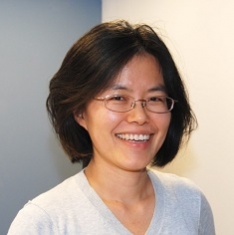
Chin-Hsien (Emily) Tai
- Center for Cancer Research
- National Cancer Institute
- Bldg. 37, Rm 5120
- Bethesda, MD 20892-4262
- 240-760-7887
- taic@mail.nih.gov
RESEARCH SUMMARY
Emily’s research focuses on protein structure comparison, structure modeling, and Next Generation Sequencing Analysis. Her excellent analytic skills have contributed to a wide range of studies from prokaryotes genetics, preclinical animal models to patient clinical trials data analysis and antigen-antibody complex modeling.
Areas of Expertise
Research
Emily developed programs to compare protein structures, to generate more accurate alignments and to parse protein structures into domains in a reliable and rational fashion. She also has interests in studying protein structures with internal symmetry. She was instrumental in CASP6 and CASP10 assessing template-free modeling, and was one of the organizers for the new categories CASP_ROLL in CASP10 and CASP_COMMONS in CASP13. Currently, she performs Next Generation Sequencing Analysis and structural modeling for different studies in the LMB.
Publications
- Bibliography Link
- View Emily Tai's PubMed Summary
Poor correlation between T-cell activation assays and HLA-DR binding prediction algorithms in an immunogenic fragment of Pseudomonas exotoxin A
Assessment of template-free modeling in CASP10 and ROLL
Biography

Chin-Hsien (Emily) Tai
Emily obtained her BS in Zoology and MS in Immunology from National Taiwan University while studying T-cell signal transduction in the Institute of Molecular Biology, Academia Sinica in Taipei, Taiwan. She received another MS in Computer and Information Science from New Jersey Institute of Technology. Before joining the Molecular Modeling and Bioinformatics Section in LMB/CCR/NCI as a staff scientist in 2002, she was a Programmer Analyst at Information Technology Division in Equities Trading Division in Goldman, Sachs & Co. in New York City, and global Compliance Reporting Division Goldman, Sachs International Ltd. in London as well. Emily played key roles in CASP6 and CASP10 assessment for new fold and template free protein structure predictions, and was instrumental for the new CASP_COMMONS in CASP13. She received NCI Travel Award in 2014 and 2015 consecutively, and her data analysis contributed to her colleague's 2019 NCI Director’s Innovation Award.
Emily was elected as the Co-Chair of the NCI CCR SSSC Organization and served in 2016 - 2018. She is also one of the founding members of the NIH Federation of Asian American, Native Hawaiian and Pacific Islander Network (NIH FAN) and currently the Co-Chair of the NIH Staff Scientist Organization Displacement Committee.
Resources
SymD Web Server: Symmetry Detection (SymD) is a tool for detecting internally symmetric protein structures.
Seed Extension Algorithm (SE) is a novel algorithm for deriving sequence alignment from a pair of superimposed structures. It does not use a gap penalty as the dynamic programming algorithm does and usually generates a more accurate alignment using less CPU time.
NDO (Normalized Domain Overlap) scoring scheme was developed when we assessed the domain boundary prediction in CASP6.
